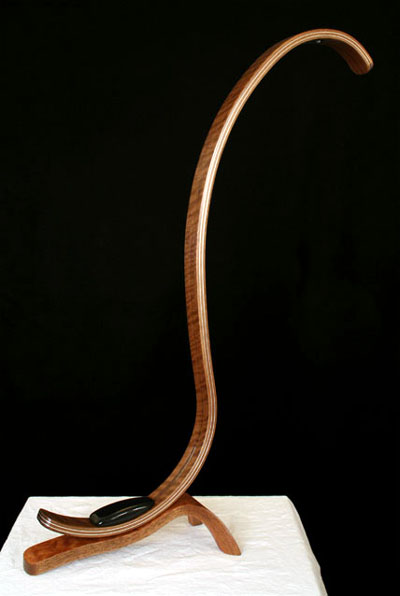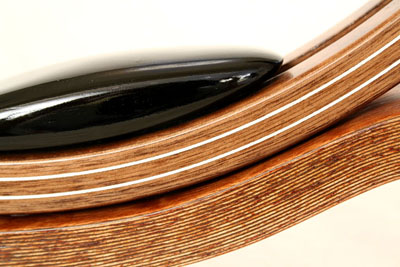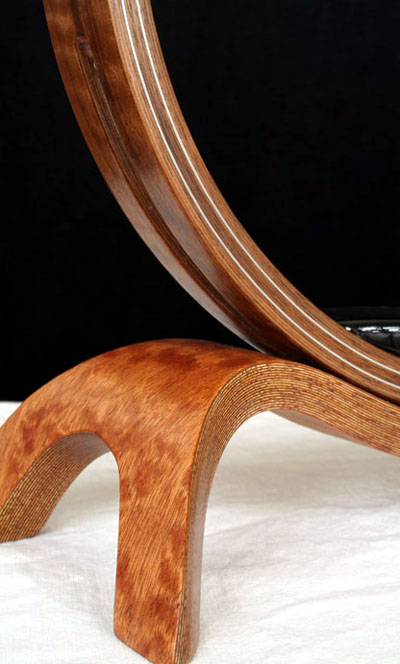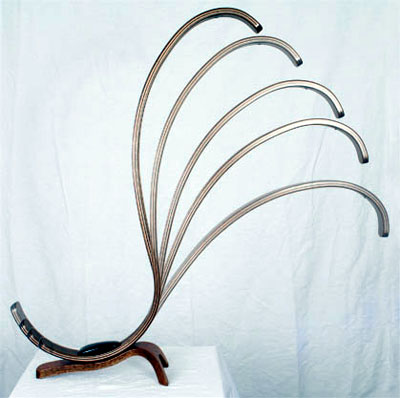I finally finished an ambitious project of making a
bent-wood laminated reading lamp!
The main arm of the lamp is made from walnut veneers,
and faced with curly walnut veneer.
Two of the laminates are aluminum, which is how the
low current gets to the LED at the top of the arm.
The base is made from layers of mahogany, and faced
with quilted Sapele.
A piece of ebony was carved and a nut was embedded
into it which captures a hex bolt coming from the
base and through a slot in the arm.
This allows the arm to pivot around an imaginary axis.
Anyway, thought I'd put it up here for questions and
comments and since I learned a lot doing this and
thought I might be able to help somebody in the future.
And yes, the intent was something that was functional,
but still largely sculptural.
The light is a high-power 3-watt Luxeon LED.
It's embedded into the top curve of the arm, and you
can see the dimple just sticking out on the first
picture.
Even though its an LED, it still makes heat and must
be attached to a heat-sink... so I used thermal epoxy
to affix it to one of the aluminum lanminates, which
should provide enough heat sinking.
I didn't have it attached in the photographs, but the
power cord attaches to the end of the arm and goes to
a small box that has the microcontroller that powers
the LED.
There's a cord that plugs into the bottom of the arm,
that runs to a box with the microcontroller.
That box gets its power from a transformer that plugs
into the electrical outlet.
The microcontroller makes sure that whatever the input
voltage (anywhere between 9 and 35 volts), the output
is 1000mA, which is the maximum continuous drive for a
3w Luxeon.
The box also gives the ability to dim, which, with
these types of LEDs, is not done best with just a
potentiometer.
It uses frequency modulation or some such thing that
I don't quite understand.
As for a picture of it lit up, I've added one here.
The 3 watt LEDs are unfortunately only available in
white (and other colors) but not "Warm White" which the
1 watt ones are available in.
So I am probably going to build some kind of curved
shade made out of rice paper or something to yellow
and soften the light. Fore more information on these
LEDs, you can read papers at
For purchasing, I recommend
or
I've ordered from both and both were very reliable
and professional.
These are not anything like the LEDs you see in
consumer electronics and are VERY bright.
I have a flashlight that has a 5 watt LED in it
(unfortunately a VERY expensive flashlight) that
is unbelievably bright and will temporarily disorient
somebody if shined in their eyes at night.
Lots of fun to encorporate these as backlights, etc,
into projects.
As for how concentrated the light is, it's not.
Lumileds makes a LED that has optics affixed to the
top which colimate the beam and I probably should
have used that.
Honestly, I'm still somewhat reworking that part of
the design.
Without it, the LEDs have something like a 130 degree
spread.
With optics, it's like 20.
Other answers... what kind of glue did I use?
I used T-88 structural epoxy for the main arm of the
lamp because epoxy sticks better to metal than wood
glue (which won't stick at all).
That being said, I chemically etched the aluminum
with a kit from West System designed exactly for that
purpose.
It makes it so that the aluminum oxide doesn't form
on the metal, which is what prevents glue from really
sticking to the aluminum.
Anyway, it worked and that arm is STRONG with no gaps.
If I had to do it again, I would use regular
West System epoxy and not System Three T-88 because
the T-88 is SO thick... much thicker than I realized
and I had a hell of a time spreading it on both sides
of 12 wood laminates and 2 metal ones.
The base was glued together with URAC 185 which is a
resin-based glue that I love.
|




|
|